Chromium
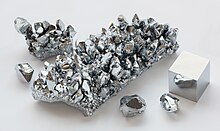 | ||||||||||||||||||||||||||||||||||||||
| Chromium | ||||||||||||||||||||||||||||||||||||||
|---|---|---|---|---|---|---|---|---|---|---|---|---|---|---|---|---|---|---|---|---|---|---|---|---|---|---|---|---|---|---|---|---|---|---|---|---|---|---|
| Appearance | silvery metallic | |||||||||||||||||||||||||||||||||||||
| Standard atomic weight Ar°(Cr) | ||||||||||||||||||||||||||||||||||||||
| Chromium in the periodic table | ||||||||||||||||||||||||||||||||||||||
| ||||||||||||||||||||||||||||||||||||||
kJ/mol | ||||||||||||||||||||||||||||||||||||||
| Heat of vaporization | 347 kJ/mol | |||||||||||||||||||||||||||||||||||||
| Molar heat capacity | 23.35 J/(mol·K) | |||||||||||||||||||||||||||||||||||||
Vapor pressure
| ||||||||||||||||||||||||||||||||||||||
| Atomic properties | ||||||||||||||||||||||||||||||||||||||
Discovery and first isolation | Louis Nicolas Vauquelin (1794, 1797) | |||||||||||||||||||||||||||||||||||||
| Isotopes of chromium | ||||||||||||||||||||||||||||||||||||||
| ||||||||||||||||||||||||||||||||||||||
Chromium is a
Chromium metal is valued for its high corrosion resistance and hardness. A major development in steel production was the discovery that steel could be made highly resistant to corrosion and discoloration by adding metallic chromium to form stainless steel. Stainless steel and chrome plating (electroplating with chromium) together comprise 85% of the commercial use. Chromium is also greatly valued as a metal that is able to be highly polished while resisting tarnishing. Polished chromium reflects almost 70% of the visible spectrum, and almost 90% of infrared light.[8] The name of the element is derived from the Greek word χρῶμα, chrōma, meaning color,[9] because many chromium compounds are intensely colored.
Industrial production of chromium proceeds from
In the United States,
While chromium metal and Cr(III) ions are considered non-toxic,
Abandoned chromium production sites often require environmental cleanup.[13]
Physical properties
Atomic
Chromium is the fourth transition metal found on the periodic table, and has a ground-state electron configuration of [Ar] 3d5 4s1. It is the first element in the periodic table whose configuration violates the Aufbau principle. Exceptions to the principle also occur later in the periodic table for elements such as copper, niobium and molybdenum.[14]
Chromium is the first element in the 3d series where the 3d electrons start to sink into the core; they thus contribute less to
Bulk

Chromium is extremely
Chromium has a
Chromium has a high
Passivation
Chromium metal left standing in air is passivated - it forms a thin, protective, surface layer of oxide. This layer has a spinel structure a few atomic layers thick; it is very dense and inhibits the diffusion of oxygen into the underlying metal. In contrast, iron forms a more porous oxide through which oxygen can migrate, causing continued rusting.[18] Passivation can be enhanced by short contact with oxidizing acids like nitric acid. Passivated chromium is stable against acids. Passivation can be removed with a strong reducing agent that destroys the protective oxide layer on the metal. Chromium metal treated in this way readily dissolves in weak acids.[19]
Chromium, unlike iron and nickel, does not suffer from hydrogen embrittlement. However, it does suffer from nitrogen embrittlement, reacting with nitrogen from air and forming brittle nitrides at the high temperatures necessary to work the metal parts.[20]
Isotopes
Naturally occurring chromium is composed of four stable
53Cr is the
Chemistry and compounds

Chromium is a member of group 6, of the transition metals. The +3 and +6 states occur most commonly within chromium compounds, followed by +2; charges of +1, +4 and +5 for chromium are rare, but do nevertheless occasionally exist.[26][27]
Common oxidation states
| Oxidation states[note 2][27] | |
|---|---|
| −4 (d10) | Na4[Cr(CO)4][28] |
| −2 (d8) | Na 2[Cr(CO) 5] |
| −1 (d7) | Na 2[Cr 2(CO) 10] |
| 0 (d6) | Cr(C 6H 6) 2 |
| +1 (d5) | K 3[Cr(CN) 5NO] |
| +2 (d4) | CrCl 2 |
| +3 (d3) | CrCl 3 |
| +4 (d2) | K 2CrF 6 |
| +5 (d1) | K 3Cr(O 2) 4 |
| +6 (d0) | K 2CrO 4 |
Chromium(0)
Many Cr(0) complexes are known. Bis(benzene)chromium and chromium hexacarbonyl are highlights in organochromium chemistry.
Chromium(II)

Chromium(II) compounds are uncommon, in part because they readily oxidize to chromium(III) derivatives in air. Water-stable chromium(II) chloride CrCl
2 that can be made by reducing chromium(III) chloride with zinc. The resulting bright blue solution created from dissolving chromium(II) chloride is stable at neutral pH.[19] Some other notable chromium(II) compounds include chromium(II) oxide CrO, and chromium(II) sulfate CrSO
4. Many chromium(II) carboxylates are known. The red chromium(II) acetate (Cr2(O2CCH3)4) is somewhat famous. It features a Cr-Cr quadruple bond.[29]
Chromium(III)
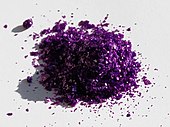
A large number of chromium(III) compounds are known, such as
(radius 50 pm), and they can replace each other in some compounds, such as in chrome alum and alum
Chromium(III) tends to form
Chromium(III) hydroxide (Cr(OH)3) is amphoteric, dissolving in acidic solutions to form [Cr(H2O)6]3+, and in basic solutions to form [Cr(OH)
6]3−
. It is dehydrated by heating to form the green chromium(III) oxide (Cr2O3), a stable oxide with a crystal structure identical to that of corundum.[19]
Chromium(VI)
Chromium(VI) compounds are oxidants at low or neutral pH. Chromate anions (CrO2−
4) and dichromate (Cr2O72−) anions are the principal ions at this oxidation state. They exist at an equilibrium, determined by pH:
- 2 [CrO4]2− + 2 H+ ⇌ [Cr2O7]2− + H2O
Chromium(VI) oxyhalides are known also and include chromyl fluoride (CrO2F2) and chromyl chloride (CrO
2Cl
2).[19] However, despite several erroneous claims, chromium hexafluoride (as well as all higher hexahalides) remains unknown, as of 2020.[34]

Sodium chromate is produced industrially by the oxidative roasting of chromite ore with sodium carbonate. The change in equilibrium is visible by a change from yellow (chromate) to orange (dichromate), such as when an acid is added to a neutral solution of potassium chromate. At yet lower pH values, further condensation to more complex oxyanions of chromium is possible.
Both the chromate and dichromate anions are strong oxidizing reagents at low pH:[19]
- Cr
2O2−
7 + 14 H
3O+
+ 6 e− → 2 Cr3+
+ 21 H
2O (ε0 = 1.33 V)
They are, however, only moderately oxidizing at high pH:[19]
- CrO2−
4 + 4 H
2O + 3 e− → Cr(OH)
3 + 5 OH−
(ε0 = −0.13 V)

Chromium(VI) compounds in solution can be detected by adding an acidic
5·OR
2.[19]
Other oxidation states
Compounds of chromium(V) are rather rare; the oxidation state +5 is only realized in few compounds but are intermediates in many reactions involving oxidations by chromate. The only binary compound is the volatile
Compounds of chromium(IV) are slightly more common than those of chromium(V). The tetrahalides, CrF4, CrCl4, and CrBr4, can be produced by treating the trihalides (CrX
3) with the corresponding halogen at elevated temperatures. Such compounds are susceptible to disproportionation reactions and are not stable in water. Organic compounds containing Cr(IV) state such as chromium tetra t-butoxide are also known.[36]
Most chromium(I) compounds are obtained solely by oxidation of electron-rich,

Occurrence
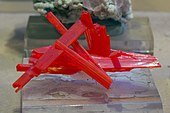

Chromium is the 21st[38] most abundant element in Earth's crust with an average concentration of 100 ppm. Chromium compounds are found in the environment from the erosion of chromium-containing rocks, and can be redistributed by volcanic eruptions. Typical background concentrations of chromium in environmental media are: atmosphere <10 ng/m3; soil <500 mg/kg; vegetation <0.5 mg/kg; freshwater <10 μg/L; seawater <1 μg/L; sediment <80 mg/kg.[39] Chromium is mined as chromite (FeCr2O4) ore.[40]
About two-fifths of the chromite ores and concentrates in the world are produced in South Africa, about a third in Kazakhstan,
The relation between Cr(III) and Cr(VI) strongly depends on
History
Early applications
Chromium minerals as pigments came to the attention of the west in the eighteenth century. On 26 July 1761, Johann Gottlob Lehmann found an orange-red mineral in the Beryozovskoye mines in the Ural Mountains which he named Siberian red lead.[47][48] Though misidentified as a lead compound with selenium and iron components, the mineral was in fact crocoite with a formula of PbCrO4.[49] In 1770, Peter Simon Pallas visited the same site as Lehmann and found a red lead mineral that was discovered to possess useful properties as a pigment in paints. After Pallas, the use of Siberian red lead as a paint pigment began to develop rapidly throughout the region.[50] Crocoite would be the principal source of chromium in pigments until the discovery of chromite many years later.[51]
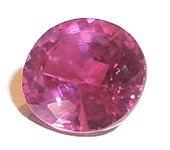
In 1794,
During the nineteenth century, chromium was primarily used not only as a component of paints, but in tanning salts as well. For quite some time, the crocoite found in Russia was the main source for such tanning materials. In 1827, a larger chromite deposit was discovered near Baltimore, United States, which quickly met the demand for tanning salts much more adequately than the crocoite that had been used previously.[55] This made the United States the largest producer of chromium products until the year 1848, when larger deposits of chromite were uncovered near the city of Bursa, Turkey.[40] With the development of metallurgy and chemical industries in the Western world, the need for chromium increased.[56]
Chromium is also famous for its reflective, metallic luster when polished. It is used as a protective and decorative coating on car parts, plumbing fixtures, furniture parts and many other items, usually applied by electroplating. Chromium was used for electroplating as early as 1848, but this use only became widespread with the development of an improved process in 1924.[57]
Production


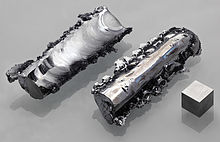
Approximately 28.8 million metric tons (Mt) of marketable chromite ore was produced in 2013, and converted into 7.5 Mt of ferrochromium.[42] According to John F. Papp, writing for the USGS, "Ferrochromium is the leading end use of chromite ore, [and] stainless steel is the leading end use of ferrochromium."[42]
The largest producers of chromium ore in 2013 have been South Africa (48%), Kazakhstan (13%), Turkey (11%), and India (10%), with several other countries producing the rest of about 18% of the world production.[42]
The two main products of chromium ore refining are

For the production of pure chromium, the iron must be separated from the chromium in a two step roasting and leaching process. The chromite ore is heated with a mixture of
- 4 FeCr2O4 + 8 Na2CO3 + 7 O2 → 8 Na2CrO4 + 2 Fe2O3 + 8 CO2
- 2 Na2CrO4 + H2SO4 → Na2Cr2O7 + Na2SO4 + H2O
The dichromate is converted to the chromium(III) oxide by reduction with carbon and then reduced in an aluminothermic reaction to chromium.[58]
- Na2Cr2O7 + 2 C → Cr2O3 + Na2CO3 + CO
- Cr2O3 + 2 Al → Al2O3 + 2 Cr
Applications
The creation of metal alloys account for 85% of the available chromium's usage. The remainder of chromium is used in the chemical, refractory, and foundry industries.[60]
Metallurgy

The strengthening effect of forming stable metal carbides at grain boundaries, and the strong increase in corrosion resistance made chromium an important alloying material for steel.

The high hardness and corrosion resistance of unalloyed chromium makes it a reliable metal for surface coating; it is still the most popular metal for sheet coating, with its above-average durability, compared to other coating metals.
In the chromate conversion coating process, the strong oxidative properties of chromates are used to deposit a protective oxide layer on metals like aluminium, zinc, and cadmium. This passivation and the self-healing properties of the chromate stored in the chromate conversion coating, which is able to migrate to local defects, are the benefits of this coating method.[69] Because of environmental and health regulations on chromates, alternative coating methods are under development.[70]
Chromic acid anodizing (or Type I anodizing) of aluminium is another electrochemical process that does not lead to the deposition of chromium, but uses chromic acid as an electrolyte in the solution. During anodization, an oxide layer is formed on the aluminium. The use of chromic acid, instead of the normally used sulfuric acid, leads to a slight difference of these oxide layers.[71] The high toxicity of Cr(VI) compounds, used in the established chromium electroplating process, and the strengthening of safety and environmental regulations demand a search for substitutes for chromium, or at least a change to less toxic chromium(III) compounds.[57]
Pigment
The mineral
Chromium oxides are also used as a green pigment in the field of glassmaking and also as a glaze for ceramics.[73] Green chromium oxide is extremely lightfast and as such is used in cladding coatings. It is also the main ingredient in infrared reflecting paints, used by the armed forces to paint vehicles and to give them the same infrared reflectance as green leaves.[74]
Other uses
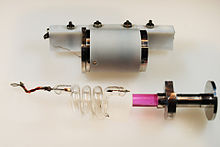
Chromium(III) ions present in corundum crystals (aluminium oxide) cause them to be colored red; when corundum appears as such, it is known as a ruby. If the corundum is lacking in chromium(III) ions, it is known as a sapphire.[note 3] A red-colored artificial ruby may also be achieved by doping chromium(III) into artificial corundum crystals, thus making chromium a requirement for making synthetic rubies.[note 4][75] Such a synthetic ruby crystal was the basis for the first laser, produced in 1960, which relied on stimulated emission of light from the chromium atoms in such a crystal. Ruby has a laser transition at 694.3 nanometers, in a deep red color.[76]
Because of their toxicity, chromium(VI) salts are used for the preservation of wood. For example,
Chromium(III) salts, especially chrome alum and chromium(III) sulfate, are used in the tanning of leather. The chromium(III) stabilizes the leather by cross linking the collagen fibers.[78] Chromium tanned leather can contain 4–5% of chromium, which is tightly bound to the proteins.[40] Although the form of chromium used for tanning is not the toxic hexavalent variety, there remains interest in management of chromium in the tanning industry. Recovery and reuse, direct/indirect recycling,[79] and "chrome-less" or "chrome-free" tanning are practiced to better manage chromium usage.[80]
The high heat resistivity and high melting point makes
Several chromium compounds are used as
Chromates of metals are used in humistor.[86]
Uses of compounds
- audio cassettes.[87]
- Chromium(III) oxide (Cr2O3) is a metal polish known as green rouge.[88][89]
- Chromic acid is a powerful oxidizing agent and is a useful compound for cleaning laboratory glassware of any trace of organic compounds.[90] It is prepared by dissolving potassium dichromate in concentrated sulfuric acid, which is then used to wash the apparatus. Sodium dichromate is sometimes used because of its higher solubility (50 g/L versus 200 g/L respectively). The use of dichromate cleaning solutions is now phased out due to the high toxicity and environmental concerns. Modern cleaning solutions are highly effective and chromium free.[91]
- Potassium dichromate is a chemical reagent, used as a titrating agent.[92]
- Chromates are added to drilling muds to prevent corrosion of steel under wet conditions.[93]
Biological role
The biologically beneficial effects of chromium(III) are debated.[95][96] Chromium is accepted by the U.S. National Institutes of Health as a trace element for its roles in the action of insulin, a hormone that mediates the metabolism and storage of carbohydrate, fat, and protein.[10] The mechanism of its actions in the body, however, have not been defined, leaving in question the essentiality of chromium.[97][98]
In contrast, hexavalent chromium (Cr(VI) or Cr6+) is highly toxic and mutagenic.[99] Ingestion of chromium(VI) in water has been linked to stomach tumors, and it may also cause allergic contact dermatitis (ACD).[100]
"
The chromium content of common foods is generally low (1–13 micrograms per serving).[10][102] The chromium content of food varies widely, due to differences in soil mineral content, growing season, plant cultivar, and contamination during processing.[102] Chromium (and nickel) leach into food cooked in stainless steel, with the effect being largest when the cookware is new. Acidic foods that are cooked for many hours also exacerbate this effect.[103][104]
Dietary recommendations
There is disagreement on chromium's status as an essential nutrient. Governmental departments from Australia, New Zealand, India, Japan, and the United States consider chromium essential[105][106][107][108] while the European Food Safety Authority (EFSA) of the European Union does not.[109]
The U.S. National Academy of Medicine (NAM) updated the Estimated Average Requirements (EARs) and the Recommended Dietary Allowances (RDAs) for chromium in 2001. For chromium, there was insufficient information to set EARs and RDAs, so its needs are described as estimates for Adequate Intakes (AIs). The current AIs of chromium for women ages 14 through 50 is 25 μg/day, and the AIs for women ages 50 and above is 20 μg/day. The AIs for women who are pregnant are 30 μg/day, and for women who are lactating, the set AIs are 45 μg/day. The AIs for men ages 14 through 50 are 35 μg/day, and the AIs for men ages 50 and above are 30 μg/day. For children ages 1 through 13, the AIs increase with age from 0.2 μg/day up to 25 μg/day. As for safety, the NAM sets Tolerable Upper Intake Levels (ULs) for vitamins and minerals when the evidence is sufficient. In the case of chromium, there is not yet enough information, hence no UL has been established. Collectively, the EARs, RDAs, AIs, and ULs are the parameters for the nutrition recommendation system known as Dietary Reference Intake (DRI).[108] Australia and New Zealand consider chromium to be an essential nutrient, with an AI of 35 μg/day for men, 25 μg/day for women, 30 μg/day for women who are pregnant, and 45 μg/day for women who are lactating. A UL has not been set due to the lack of sufficient data.[105] India considers chromium to be an essential nutrient, with an adult recommended intake of 33 μg/day.[106] Japan also considers chromium to be an essential nutrient, with an AI of 10 μg/day for adults, including women who are pregnant or lactating. A UL has not been set.[107] The EFSA of the European Union however, does not consider chromium to be an essential nutrient; chromium is the only mineral for which the United States and the European Union disagree.[109][110]
Labeling
For U.S. food and dietary supplement labeling purposes, the amount of the substance in a serving is expressed as a percent of the Daily Value (%DV). For chromium labeling purposes, 100% of the Daily Value was 120 μg. As of 27 May 2016 the percentage of daily value was revised to 35 μg to bring the chromium intake into a consensus with the official Recommended Dietary Allowance.[111][112] A table of the old and new adult daily values is provided at Reference Daily Intake.
Food sources
Food composition databases such as those maintained by the U.S. Department of Agriculture do not contain information on the chromium content of foods.[113] A wide variety of animal and vegetable foods contain chromium.[108] Content per serving is influenced by the chromium content of the soil in which the plants are grown, by foodstuffs fed to animals, and by processing methods, as chromium is leached into foods if processed or cooked in stainless steel equipment.[114] One diet analysis study conducted in Mexico reported an average daily chromium intake of 30 micrograms.[115] An estimated 31% of adults in the United States consume multi-vitamin/mineral dietary supplements,[116] which often contain 25 to 60 micrograms of chromium.
Supplementation
Chromium is an ingredient in
Approved and disapproved health claims
In 2005, the U.S. Food and Drug Administration had approved a qualified health claim for chromium picolinate with a requirement for very specific label wording: "One small study suggests that chromium picolinate may reduce the risk of insulin resistance, and therefore possibly may reduce the risk of type 2 diabetes. FDA concludes, however, that the existence of such a relationship between chromium picolinate and either insulin resistance or type 2 diabetes is highly uncertain." At the same time, in answer to other parts of the petition, the FDA rejected claims for chromium picolinate and cardiovascular disease, retinopathy or kidney disease caused by abnormally high blood sugar levels.[120] In 2010, chromium(III) picolinate was approved by Health Canada to be used in dietary supplements. Approved labeling statements include: a factor in the maintenance of good health, provides support for healthy glucose metabolism, helps the body to metabolize carbohydrates and helps the body to metabolize fats.[121] The European Food Safety Authority (EFSA) approved claims in 2010 that chromium contributed to normal macronutrient metabolism and maintenance of normal blood glucose concentration, but rejected claims for maintenance or achievement of a normal body weight, or reduction of tiredness or fatigue.[122]
Given the evidence for chromium deficiency causing problems with glucose management in the context of intravenous nutrition products formulated without chromium,
Two
Chromium is promoted as a sports performance dietary supplement, based on the theory that it potentiates insulin activity, with anticipated results of increased muscle mass, and faster recovery of glycogen storage during post-exercise recovery.[119][130][131] A review of clinical trials reported that chromium supplementation did not improve exercise performance or increase muscle strength.[132] The International Olympic Committee reviewed dietary supplements for high-performance athletes in 2018 and concluded there was no need to increase chromium intake for athletes, nor support for claims of losing body fat.[133]
Fresh-water fish
Chromium is naturally present in the environment in trace amounts, but industrial use in rubber and stainless steel manufacturing, chrome plating, dyes for textiles, tanneries and other uses contaminates aquatic systems. In Bangladesh, rivers in or downstream from industrialized areas exhibit heavy metal contamination. Irrigation water standards for chromium are 0.1 mg/L, but some rivers are more than five times that amount. The standard for fish for human consumption is less than 1 mg/kg, but many tested samples were more than five times that amount.[134] Chromium, especially hexavalent chromium, is highly toxic to fish because it is easily absorbed across the gills, readily enters blood circulation, crosses cell membranes and bioconcentrates up the food chain. In contrast, the toxicity of trivalent chromium is very low, attributed to poor membrane permeability and little biomagnification.[135]
Acute and chronic exposure to chromium(VI) affects fish behavior, physiology, reproduction and survival. Hyperactivity and erratic swimming have been reported in contaminated environments. Egg hatching and fingerling survival are affected. In adult fish there are reports of histopathological damage to liver, kidney, muscle, intestines, and gills. Mechanisms include mutagenic gene damage and disruptions of enzyme functions.[135]
There is evidence that fish may not require chromium, but benefit from a measured amount in diet. In one study, juvenile fish gained weight on a zero chromium diet, but the addition of 500 μg of chromium in the form of chromium chloride or other supplement types, per kilogram of food (dry weight), increased weight gain. At 2,000 μg/kg the weight gain was no better than with the zero chromium diet, and there were increased DNA strand breaks.[136]
Precautions
Water-insoluble chromium(III) compounds and chromium metal are not considered a health hazard, while the toxicity and carcinogenic properties of chromium(VI) have been known for a long time.
Chromium(VI) toxicity
The acute
The
Chromium salts (chromates) are also the cause of
Environmental issues
Because chromium compounds were used in
In 2010, the Environmental Working Group studied the drinking water in 35 American cities in the first nationwide study. The study found measurable hexavalent chromium in the tap water of 31 of the cities sampled, with Norman, Oklahoma, at the top of list; 25 cities had levels that exceeded California's proposed limit.[149]
The more toxic hexavalent chromium form can be reduced to the less soluble trivalent oxidation state in soils by organic matter, ferrous iron, sulfides, and other reducing agents, with the rates of such reduction being faster under more acidic conditions than under more alkaline ones. In contrast, trivalent chromium can be oxidized to hexavalent chromium in soils by manganese oxides, such as Mn(III) and Mn(IV) compounds. Since the solubility and toxicity of chromium (VI) are greater that those of chromium (III), the oxidation-reduction conversions between the two oxidation states have implications for movement and bioavailability of chromium in soils, groundwater, and plants.[150]
Notes
- ^ The melting/boiling point of transition metals are usually higher compared to the alkali metals, alkaline earth metals, and nonmetals, which is why the range of elements compared to chromium differed between comparisons
- ^ Most common oxidation states of chromium are in bold. The right column lists a representative compound for each oxidation state.
- ^ Any color of corundum (disregarding red) is known as a sapphire. If the corundum is red, then it is a ruby. Sapphires are not required to be blue corundum crystals, as sapphires can be other colors such as yellow and purple
- pink sapphire or rubyis formed, depending on the amount of chromium.
References
- ^ "Standard Atomic Weights: Chromium". CIAAW. 1983.
- ISSN 1365-3075.
- ^ ISBN 978-1-62708-155-9.
- ^ .
- ISBN 0-8493-0464-4.
- ^ .
- S2CID 4221048.
- ^ a b c Coblentz, WW; Stair, R. "Reflecting power of beryllium, chromium, and several other metals" (PDF). National Institute of Standards and Technology. NIST Publications. Retrieved 11 October 2018.
- ^ χρῶμα, Henry George Liddell, Robert Scott, A Greek-English Lexicon, on Perseus
- ^ a b c d e f "Chromium". Office of Dietary Supplements, US National Institutes of Health. 2016. Retrieved 26 June 2016.
- ^ "Scientific Opinion on Dietary Reference Values for chromium". European Food Safety Authority. 18 September 2014. Retrieved 20 March 2018.
- ^ "Substance Information - ECHA". echa.europa.eu. Retrieved 17 January 2022.
- ^ EPA (August 2000). "Abandoned Mine Site Characterization and Cleanup Handbook" (PDF). United States Environmental Protection Agency. Retrieved 8 September 2019.
- ^ "The Nature of X-Ray Photoelectron Spectra". CasaXPS. Casa Software Ltd. 2005. Retrieved 10 March 2019.
- ^ Greenwood and Earnshaw, pp. 1004–5
- ^ Bibcode:1972PhDT........54L. Retrieved 4 November 2018.
- Bibcode:1969PhDT.......118B. Retrieved 4 November 2018.
- S2CID 250853920.
- ^ ISBN 978-3-11-007511-3.
- ISBN 978-0-309-01769-5.
- ^ "Live Chart of Nuclides". International Atomic Energy Agency - Nuclear Data Section. Retrieved 18 October 2018.
- .
- S2CID 4373201.
- ^ PMID 15092973.
- ^ Puigdomenech, Ignasi Hydra/Medusa Chemical Equilibrium Database and Plotting Software Archived 5 June 2013 at the Wayback Machine (2004) KTH Royal Institute of Technology
- ^ Clark, Jim. "Oxidation states (oxidation numbers)". Chemguide. Retrieved 3 October 2018.
- ^ ISBN 978-0-08-037941-8.
- ISBN 978-1-119-95143-8.
- ISBN 978-0-19-855649-7.
- ^ "Chromium(III) compounds". National Pollutant Inventory. Commonwealth of Australia. Retrieved 8 November 2018.
- . Retrieved 8 November 2018.
- ISBN 978-1-118-85137-1. Retrieved 7 August 2019.
- PMID 31967803.
- PMID 25418862.
- ^ Haxhillazi, Gentiana (2003). Preparation, Structure and Vibrational Spectroscopy of Tetraperoxo Complexes of CrV+, VV+, NbV+ and TaV+ (PhD thesis). University of Siegen.
- ISSN 0020-1669.
- S2CID 42853922.
- ISBN 978-0-19-850340-8.
- ISBN 978-1-135-12679-7.
- ^ ISBN 978-0-309-02217-0.
- ^ Champion, Marc (11 January 2018). "How a Trump SoHo Partner Ended Up With Toxic Mining Riches From Kazakhstan". Bloomberg.com. Bloomberg L.P. Retrieved 21 January 2018.
- ^ a b c d Papp, John F. "Mineral Yearbook 2015: Chromium" (PDF). United States Geological Survey. Retrieved 3 June 2015.
- ^ Fleischer, Michael (1982). "New Mineral Names" (PDF). American Mineralogist. 67: 854–860.
- ^ Chromium (with location data), Mindat.
- ^ Chromium from Udachnaya-Vostochnaya pipe, Daldyn, Daldyn-Alakit kimberlite field, Saha Republic (Sakha Republic; Yakutia), Eastern-Siberian Region, Russia, Mindat.
- PMID 16124280.
- OCLC 913810356.
- ^ Lehmanni, Iohannis Gottlob (1766). De Nova Minerae Plumbi Specie Crystallina Rubra, Epistola.
- ^ ISBN 978-1-56670-608-7.
- ISSN 0021-9584.
- ^ Casteran, Rene. "Chromite mining". Oregon Encyclopedia. Portland State University and the Oregon Historical Society. Retrieved 1 October 2018.
- ^ Vauquelin, Louis Nicolas (1798). "Memoir on a New Metallic Acid which exists in the Red Lead of Siberia". Journal of Natural Philosophy, Chemistry, and the Arts. 3: 145–146.
- ^ Glenn, William (1895). "Chrome in the Southern Appalachian Region". Transactions of the American Institute of Mining, Metallurgical and Petroleum Engineers. 25: 482.
- ^ van der Krogt, Peter. "Chromium". Retrieved 24 August 2008.
- ^ Ortt, Richard A Jr. "Soldier's Delight, Baltimore Country". Maryland Department of Natural Resources. Maryland Geological Survey. Retrieved 13 May 2019.
- ^ Bilgin, Arif; Çağlar, Burhan (eds.). Klasikten Moderne Osmanlı Ekonomisi. Turkey: Kronik Kitap. p. 240.
- ^ ISBN 978-1-85573-081-6.
- ^ ISBN 978-0-87335-233-8.
- ^ Papp, John F. "Mineral Yearbook 2002: Chromium" (PDF). United States Geological Survey. Retrieved 16 February 2009.
- ISBN 978-0-08-049478-4.
- OCLC 43083287. Archived from the originalon 1 July 2021. Retrieved 5 October 2018.
- ^ Bhadeshia, HK. "Nickel-Based Superalloys". University of Cambridge. Archived from the original on 25 August 2006. Retrieved 17 February 2009.
- ^ "Chromium, Nickel and Welding". IARC Monographs. 49. International Agency for Research on Cancer: 49–50. 1990.
- ^ "Stainless Steel Grade 332 (UNS S33200)". AZoNetwork. 5 March 2013.
- ^ "Super Alloy INCOLOY Alloy 800 (UNS N08800)". AZoNetwork. 3 July 2013.
- ^ "Manual On Uniform Traffic Control Devices (War Emergency Edition)" (PDF). Washington, DC: American Associan of State Highway Officials. November 1942. p. 52. Retrieved 8 July 2021.
- ^ State Department, United States. "Allied Relations and Negotiations with Turkey" (PDF). Archived (PDF) from the original on 9 November 2020.
- ^ Breitsameter, M (15 August 2002). "Thermal Spraying versus Hard Chrome Plating". Azo Materials. AZoNetwork. Retrieved 1 October 2018.
- ISBN 978-0-904477-16-0.
- hdl:1811/36519.
- ISBN 978-0-87170-384-2. Retrieved 17 February 2009.
- ISBN 978-0-486-21597-6.
- ISBN 978-0-85404-604-1.
- .
- ISBN 978-0-7503-0963-9.
- ^ PMID 11202715.
- ^ Brown, EM (1997). "A Conformational Study of Collagen as Affected by Tanning Procedures". Journal of the American Leather Chemists Association. 92: 225–233.
- .
- .
- PMID 9380835.
- S2CID 98324455.
- ISBN 978-0-7234-0857-4.
- .
- ^ Lazier, WA & Arnold, HR (1939). "Copper Chromite Catalyst". Organic Syntheses. 19: 31; Collected Volumes, vol. 2, p. 142.
- .
- ISBN 978-0-12-466626-9.
- ISBN 978-1-4377-7860-1.
- .
- ^ Soderberg, Tim (3 June 2019). "Oxidizing Agents". LibreTexts. MindTouch. Retrieved 8 September 2019.
- ISBN 978-1-56396-259-2.
- ^ Lancashire, Robert J (27 October 2008). "Determination of iron using potassium dichromate: Redox indicators". The Department of Chemistry UWI, Jamaica. Retrieved 8 September 2019.
- ISBN 978-0-87170-505-1.
- ISBN 978-1-119-42388-1.
- PMID 24470092.
- )
- .
- S2CID 22376660.
- PMID 22192535.
- ^ "ToxFAQs: Chromium". Agency for Toxic Substances & Disease Registry, Centers for Disease Control and Prevention. February 2001. Archived from the original on 8 July 2014. Retrieved 2 October 2007.
- S2CID 16895342.
- ^ PMID 23066174.
- PMID 23984718.
- PMID 9102344.
- ^ a b "Chromium". Nutrient Reference Values for Australia and New Zealand. 2014. Retrieved 4 October 2018.
- ^ a b "Nutrient Requirements and Recommended Dietary Allowances for Indians: A Report of the Expert Group of the Indian Council of Medical Research. pp.283-295 (2009)" (PDF). Archived from the original (PDF) on 15 June 2016. Retrieved 3 October 2018.
- ^ a b "DRIs for Chromium (μg/day)" (PDF). Overview of Dietary Reference Intakes for Japanese. 2015. p. 41. Retrieved 4 October 2018.
- ^ a b c "Chromium. IN: Dietary Reference Intakes for Vitamin A, Vitamin K, Arsenic, Boron, Chromium, Chromium, Iodine, Iron, Manganese, Molybdenum, Nickel, Silicon, Vanadium, and Chromium". Institute of Medicine (U.S.) Panel on Micronutrients, National Academy Press. 2001. pp. 197–223. Retrieved 3 October 2018.
- ^ a b "Overview on Dietary Reference Values for the EU population as derived by the EFSA Panel on Dietetic Products, Nutrition and Allergies" (PDF). 2017.
- ^ Tolerable Upper Intake Levels For Vitamins And Minerals (PDF), European Food Safety Authority, 2006
- ^ "Federal Register May 27, 2016 Food Labeling: Revision of the Nutrition and Supplement Facts Labels. FR page 33982" (PDF).
- ^ "Daily Value Reference of the Dietary Supplement Label Database (DSLD)". Dietary Supplement Label Database (DSLD). Archived from the original on 7 April 2020. Retrieved 16 May 2020.
- ^ "USDA Food Composition Databases". United States Department of Agriculture Agricultural Research Service. April 2018. Retrieved 4 October 2018.
- ^
Kumpulainen, JT (1992). "Chromium content of foods and diets". Biological Trace Element Research. 32 (1–3): 9–18. S2CID 10189109.
- PMID 11515227.
- ^ PMID 27727382.
- ^ PMID 27049031.
- PMID 25527182.
- ^ PMID 20372701.
- ^ FDA Qualified Health Claims: Letters of Enforcement Discretion, Letters of Denial U.S. Food and Drug Administration, Docket #2004Q-0144 (August 2005).
- ^ "Monograph: Chromium (from Chromium picolinate)". Health Canada. 9 December 2009. Retrieved 18 October 2018.
- ^ a b Scientific Opinion on the substantiation of health claims related to chromium and contribution to normal macronutrient metabolism (ID 260, 401, 4665, 4666, 4667), maintenance of normal blood glucose concentrations (ID 262, 4667), contribution to the maintenance or achievement of a normal body weight (ID 339, 4665, 4666), and reduction of tiredness and fatigue (ID 261) pursuant to Article 13(1) of Regulation (EC) No 1924/2006 Archived 21 April 2020 at the Wayback Machine European Food Safety Authority EFSA J 2010;8(10)1732.
- PMID 27019254.
- PMID 23683609.
- S2CID 22326435.
- S2CID 2441511.
- PMID 27261273.
- ^ PMID 24293292.
- ^ S2CID 21832321.
- PMID 1299487.
- S2CID 9981172.
- PMID 19007050.
- PMID 29589768.
- PMID 30544988.
- ^ PMID 29854615.
- S2CID 16154712.
- PMID 10382554.
- ^ S2CID 31117557.
- S2CID 21033504.
- ^ NIOSH Pocket Guide to Chemical Hazards. "#0141". National Institute for Occupational Safety and Health (NIOSH).
- S2CID 31351037.
- ^ Newman, D. (1890). "A case of adeno-carcinoma of the left inferior turbinated body, and perforation of the nasal septum, in the person of a worker in chrome pigments". Glasgow Medical Journal. 33: 469–470.
- PMID 2405656.
- PMID 8260068.
- ^ Methods to Develop Inhalation Cancer Risk Estimates for Chromium and Nickel Compounds. Research Triangle Park, NC: U.S. Environmental Protection Agency, Office of Air Quality Planning and Standards, Health and Environmental Impacts Division. 2011. Retrieved 19 March 2015.
- ^ Ngan, V (2002). "Chrome Allergy". DermNet NZ.
- S2CID 45426346.
- ISBN 978-0-9626523-7-0.
- Yahoo News. 19 December 2010. Archived from the originalon 23 December 2010. Retrieved 19 December 2010.
- PMID 21648723.
General bibliography
- ISBN 978-0-08-037941-8.
External links
- ATSDR Case Studies in Environmental Medicine: Chromium Toxicity U.S. Department of Health and Human Services
- IARC Monograph "Chromium and Chromium compounds"
- It's Elemental – The Element Chromium
- The Merck Manual – Mineral Deficiency and Toxicity
- National Institute for Occupational Safety and Health – Chromium Page
- Chromium at The Periodic Table of Videos(University of Nottingham)
- . Encyclopædia Britannica. Vol. 6 (11th ed.). 1911. pp. 296–298.
